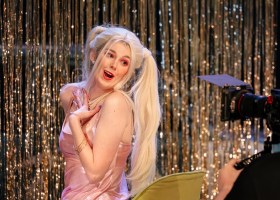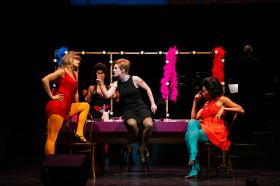‘White. A blank page or canvas. So many possibilities.’ These are the final lines of Sunday in the Park with George, reminding us of the challenge every artist faces, whatever the chosen medium. While the artists of Victorian Opera may not have been faced with quite the same blank canvas that faced Georges Seurat, the possibilities offered in mounting a production of this famous piece of musical theatre are considerable. In this case, the challenges have been met with impressive skill and creativity. The work itself, its staging and performance have been brought together in a harmonious whole to move and delight. There is not one weak link in this production.
Since Sondheim’s and Lapine’s work is focused on the life of an artist at the centre of Post-Impressionism, the visual content of any staging is crucial. Victorian Opera has dedicated this season to the memory of Wolfe, the son of Dan Aulich and Tirion Rodwell, the highly talented costume-maker for the company. Her transformation of Anna Cordingley’s striking designs celebrates his life and connects to a reiterated theme of the text: the importance of ‘children and art’ – our bequests to the future. The costumes, modeled on those depicted in Seurat’s masterpiece, A Sunday on La Grande Jatte, are indeed beautifully constructed in colourful fabrics painted in impressionistic designs. The sets are highly functional, allowing smooth transitions between scenes and various incarnations of Seurat’s painting. Tableaux spring to life, becoming characters in personal exchanges with the painter. These transitions were executed seamlessly by the singers – a tribute to the experienced guiding hand of director, Stuart Maunder.
As Georges, the 1884 Parisian painter of Act 1, and George the 1984 New York ‘chromolume’ sculptor of Act 2, Alexander Lewis is terrific. His tenor is clear, ringing and effortless, even when he uses his falsetto to deliver a conversation between two dogs. Lewis is a major talent of the musical theatre scene and not to be missed. His portrayal of an almost autistic single-minded devotion to art and to the pursuit of the new is compelling.
As his neglected mistress and muse, Christina O’Neill is a spirited and attractive Dot. It is hard to believe that Sondheim’s choice of this name was as purely coincidental as he claims, but it is possible that the association with Pointillist painting was working at a subconscious level. Besides, you would think that he would anxious to avoid the disbelieving groans that this association is bound to elicit had he made a conscious choice. O’Neill’s youthful portrayal of the 98 year old Marie, child of Georges and grandmother of George, is sweetly sung but less convincing. At least the American accent was more appropriate than it had been in Act1.
Of the many excellent performances of a strong cast, that of Nancye Hayes stands out. She is a National Treasure of musical theatre and makes this production worth seeing just on her account. I cannot imagine anybody surpassing her incisive, focused Old Lady (Seurat’s mother) or her relatively brief appearance as a hard-bitten art critic, who tries to support George’s work in the cutthroat commercial art market of New York. She makes a telling foil to Lewis’s George as he frantically tries to ‘make connections’, schmoozing with possible patrons, trying to please them while realizing that he has to find a way to create something new. The agony of this dilemma undoubtedly reflects Sondheim’s struggles.
The cast is sizeable, with all members playing at least two roles, but one thing that they have in common is remarkably good diction. Although they wear body microphones, this is no guarantee of clarity, as some recent performances of Melbourne Theatre Company actors have demonstrated. Dimity Shepherd, Antoinette O’Halloran, David Rogers-Smith, Olivia Cranwell and Carrie Barr all give polished performances and add to the vitality of what can be a fairly cerebral work at times.
The number of musicians in Sondheim’s orchestration just coincidentally corresponds with the number of colours that Seurat used to create his luminous effects of colour and light. As the eye creates new colours from the way the dots are juxtaposed, Sondheim’s score seeks to do the same. Under the assured baton of Phoebe Briggs, the 11 musicians negotiated the score capably, nicely articulating the pointillist aspects of the music.
There are a few surprises in this splendid production, which might be better left as such; it would be a pity to take the edge off the special effects. Suffice to say, this production pays attention to detail and complexity without overburdening the piece with gimmicks. Certainly, I will never look at a Seurat painting in the same way again. We may not be able to rush off to the Art Institute of Chicago, reputedly housing the only truly great French masterpiece that is not in France, but in this production we have been offered a new and enriching experience inspired by A Sunday on La Grande Jatte.
Rating: 4 ½ stars out of 5
Sunday in the Park with George
Victorian Opera
Composer: Stephen Sondheim
Librettist: James Lapine
Director: Stuart Maunder
Conductor: Phoebe Briggs
Cast includes Alexander Lewis, Christina O’Neill, Nancye Hayes and Antoinette Halloran,
Playhouse, Arts Centre Melbourne
20-27 July






